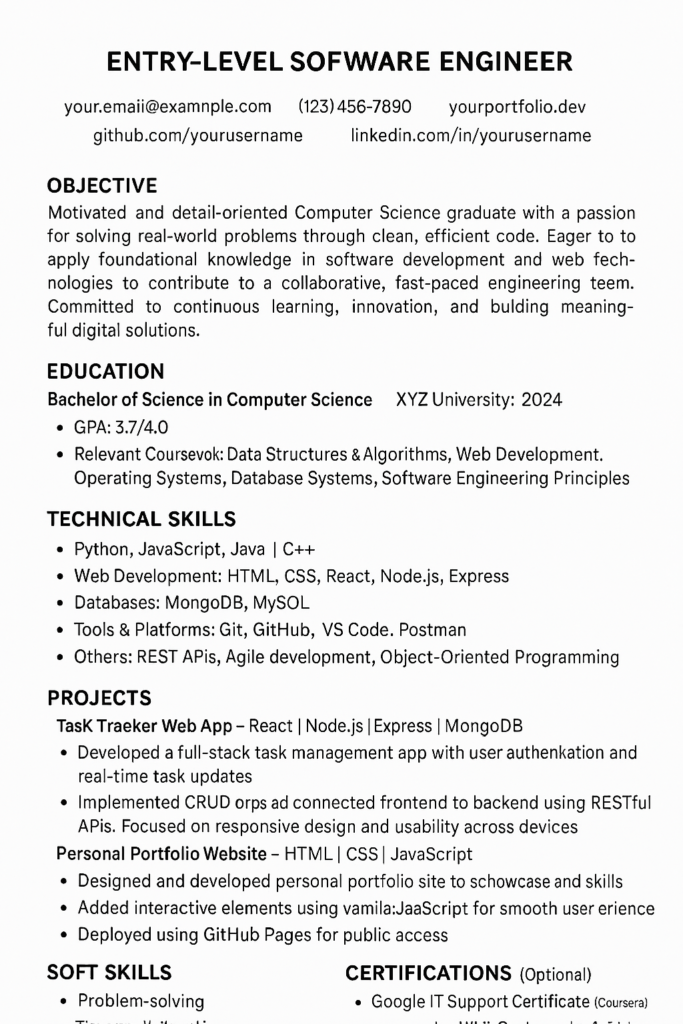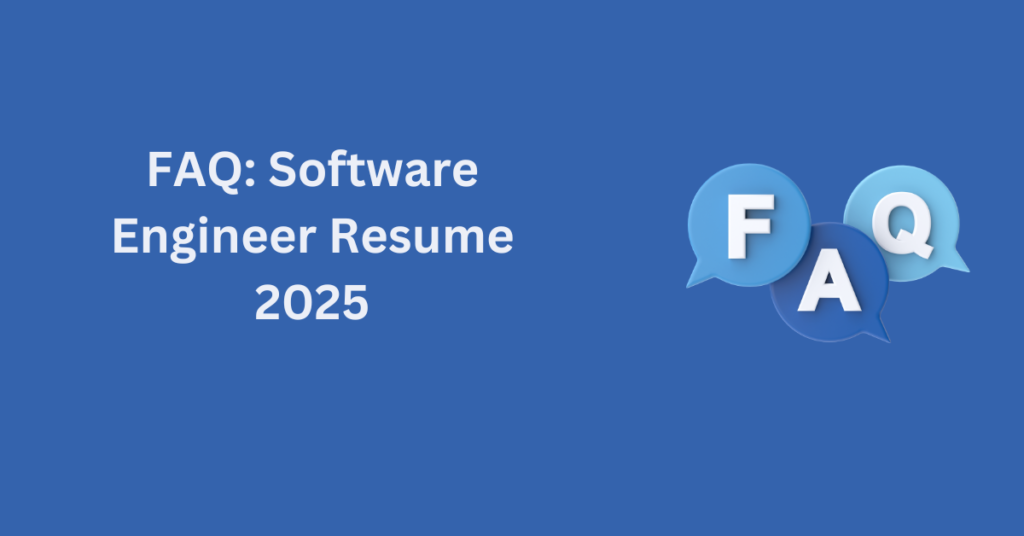Let’s be honest — trying to write a software engineer resume in 2025 kind of headache. You open a blank doc, stare at it for way too long, and think, “Where do I even begin?” You’re not alone. I’ve talked to so many smart, talented people who feel stuck in the same place. The tech world is moving so fast it’s dizzying, and somehow you’re expected to cram your entire story — your skills, your passion, your worth — into one clean, scannable page? No pressure, right?
Here’s the truth: you don’t need to be perfect. You just need a resume that sounds like you, feels like you, and shows hiring managers that you’re more than a list of tools and tech buzzwords. So let’s figure this out together — one step at a time — and write a software engineer resume that actually gets you in the door.
Understanding the Current Job Market for Software Engineers
Before you even start writing your resume, it’s important to understand what’s really happening in the job market right now. According to the U.S. Bureau of Labor Statistics, employment of software developers is projected to grow 25% from 2021 to 2031—that’s much faster than the average for all occupations. But here’s the catch: as demand rises, so does competition.
Today’s tech employers aren’t just looking for someone who can code. They’re searching for well-rounded professionals—people who can think critically, solve real-world problems, communicate clearly, and adapt to fast-paced environments. Whether you’re a fresh graduate or pivoting from another career, showcasing your technical skills alongside soft skills is no longer optional. It’s what makes you stand out.
So, if you’re wondering how to craft a software engineer resume that actually gets noticed? It starts with knowing what hiring managers value—and building your story around that.
Create Your Ats-Friendly Resume with Our Free Resume Builder
Before we dive into the must-have technical and soft skills, make sure to check out our complete Software Engineer Resume Writing Guide — it’s packed with examples, templates, and expert tips.
The Foundation: Choosing the Right Format
Your resume’s structure sets the tone. In 2025, the hybrid resume format has gained prominence. This approach combines the chronological and functional formats, allowing you to highlight both your work experience and relevant skills. Here’s how to structure it:
- Header: Your name, contact information, and LinkedIn/GitHub profiles.
- Professional Summary: A brief snapshot of your career, emphasizing your unique value proposition.
- Technical Skills: A concise list of programming languages, tools, and technologies you’re proficient in.
- Professional Experience: Detailed accounts of your roles, achievements, and the impact you’ve made.
- Education: Your academic credentials and any relevant certifications.
- Projects: Notable personal or collaborative projects that showcase your skills.
Crafting a Compelling Professional Summary
Think of your professional summary as your elevator pitch. In two to three sentences, encapsulate who you are, your expertise, and what you bring to the table. For instance:
“Innovative software engineer with 5+ years of experience in developing scalable web applications. Proficient in JavaScript, Python, and cloud services, with a passion for crafting efficient solutions to complex problems.”

Showcasing Technical Skills
In today’s tech landscape, merely listing skills isn’t enough. It’s about demonstrating proficiency and relevance. Tailor your skills section to align with the job description, ensuring you incorporate both foundational languages and emerging technologies.
- Programming Languages: JavaScript, Python, C++
- Frameworks: React, Angular, Django
- Tools & Platforms: AWS, Docker, Kubernetes
- Databases: MySQL, MongoDB
Detailing Professional Experience
This section is your opportunity to shine. Focus on achievements rather than responsibilities. Use bullet points to ensure clarity and readability. Quantify your accomplishments to provide context.
- Position Title | Company Name | Dates of Employment
- Developed and deployed a microservices architecture that reduced system downtime by 30%.
- Led a team of 5 engineers to implement a new feature, resulting in a 25% increase in user engagement.
- Optimized database queries, decreasing load times by 40%.
Highlighting Projects
Projects, especially personal ones, can set you apart. They showcase initiative, passion, and continuous learning. When detailing projects, focus on the problem, your approach, and the outcome.
- Real-time Chat Application
- Designed and developed a chat application using Node.js and Socket.io, supporting over 10,000 concurrent users with minimal latency.
Education and Certifications
While experience often takes precedence, your educational background and certifications validate your knowledge base. List your highest degree first, followed by relevant certifications.
- Bachelor of Science in Computer Science | University of Toronto | 2020
- AWS Certified Solutions Architect | 2022
Embracing Soft Skills
Technical prowess is vital, but soft skills are the glue that holds everything together. Highlighting abilities like communication, teamwork, and adaptability can make a significant difference.
- Collaborated with cross-functional teams to define project requirements and deliver solutions ahead of deadlines.
Tailoring for ATS Compatibility
With many companies utilizing Applicant Tracking Systems (ATS) to filter resumes, it’s crucial to ensure your resume is ATS-friendly.
- Using Standard Fonts: Stick to fonts like Arial, Times New Roman, or Calibri.
- Avoiding Graphics and Images: While they might look appealing, ATS may not process them correctly.
- Incorporating Keywords: Mirror the job description’s language, ensuring you naturally integrate relevant keywords.
Common Pitfalls to Avoid
Drawing from experiences shared by industry experts, here are some common mistakes to steer clear of:
- Overloading with Jargon: While it’s essential to showcase your technical knowledge, avoid excessive jargon that might alienate non-technical recruiters.
- Lengthy Resumes: Aim for clarity and conciseness. Typically, a one-page resume suffices, especially for those with less than a decade of experience.
- Generic Content: Tailor each resume to the specific role, highlighting the most relevant experiences and skills.
Real-Life Success Story
Let me tell you about Jenna.
A brilliant junior software engineer, Jenna had all the right skills—Python, React, Docker—you name it. But she was hitting a wall. Dozens of applications, and hardly a peep from recruiters. When she booked a session with me, I took one look at her resume and knew why.
It was… fine. But “fine” doesn’t get interviews in 2025.
Her resume looked like a generic template from 2017. Skills were lumped together without context, her summary was just a list of buzzwords, and she didn’t showcase any real-world achievements or side projects.
We got to work. I asked her, “What’s something you built that you’re proud of?”
She smiled, then told me about a web app she created in college that helped her university’s counseling center automate appointment scheduling. It wasn’t even on her resume.
We added it.
We rewrote her professional summary to reflect her story—not just her skills, but her curiosity, her collaborative spirit, and her impact.
Two weeks later, she had three interviews lined up. By the end of the month? She landed an offer from a fast-growing startup—doing meaningful work she loved.

How to Write a Software Engineer Resume in 2025 (Even if You’re Just Starting)
If you’re new to the field or applying for your first job, don’t worry—you still have plenty to offer. Here’s how to make a strong impression, even without loads of experience.
Use a Skills-Based Format
This format works well for freshers and career changers. Instead of leading with experience, you highlight your technical skills, certifications, coursework, and relevant projects.
Add a Strong Summary
Don’t skip this part—it’s your chance to show personality. Use it to convey your passion for learning, coding, and problem-solving. Something like:
“Entry-level software engineer with a deep love for clean, scalable code and a passion for solving real-world problems. Trained in full-stack development with a focus on JavaScript, React, and Node.js. Actively contributing to open-source projects on GitHub.”
Include Side Projects, Bootcamp Work, or Freelance Gigs
Projects show initiative. Build something small but useful and share it. Even better—link to it.
You can even add metrics:
- “Built a budgeting app that has over 1,000 downloads on the Google Play Store.”
- “Created a task manager with React and Firebase, used by 30+ classmates during final semester.”
Must-Have Skills for Software Engineer Resumes in 2025
According to LinkedIn’s 2025 Emerging Jobs Report, these are some of the most in-demand technical skills hiring managers are seeking:
- Cloud platforms (AWS, Azure, Google Cloud)
- DevOps tools (Docker, Kubernetes, Jenkins)
- Frontend frameworks (React, Angular)
- Backend technologies (Node.js, Django)
- Programming languages (Python, JavaScript, Go, Rust)
- Testing frameworks (Jest, Cypress)
- CI/CD practices
But don’t forget the soft skills that are just as critical:
- Problem-solving
- Communication
- Team collaboration
- Adaptability
- Time management
✅ Pro Tip: If you’ve led a team project, mentored peers, or participated in hackathons—mention it!
Top Resume Tips for Software Engineers
Let’s get specific. Here are real, practical tips I’ve given clients that helped them land interviews in 2025:
1. Use Active Language
Avoid weak verbs. Start bullet points with action verbs like:
- Designed
- Implemented
- Led
- Automated
- Refactored
- Optimized
2. Quantify Your Impact
Numbers get attention. Don’t just say “improved app performance.” Say:
“Reduced page load time by 40%, increasing user retention by 15%.”
3. Use White Space & Simple Layouts
Don’t cram. Use margins, headers, and bullet points to guide the eye. Keep fonts readable. A modern, ATS-friendly format is key. (Check out the free resume builder ).
4. Link to Your GitHub or Portfolio
If you’re proud of your code, show it off. Recruiters do click on GitHub links.
5. Tailor for Every Job
It’s tedious, yes. But one-size-fits-all resumes don’t work anymore. Customize your summary, skills, and even bullet points to match the role.
Tools to Help You Build an Amazing Resume
These tools can help make your resume building process easier (and better):
- Resume Worded — Helps optimize resumes with real recruiter feedback
- Novoresume — Easy-to-use templates built with hiring trends in mind
- LinkedIn Career Explorer — Great for seeing how others in your field present themselves
- Bestresumecreator — overall easy and 100 percent free Resume builder amongst all of the above.

Entry-Level Software Engineer Resume with No experience (Example)
Sample resume for software engineer with no experience
Email: your.email@example.com
Phone: (123) 456-7890
Portfolio: yourportfolio.dev
GitHub: github.com/yourusername
LinkedIn: linkedin.com/in/yourusername
Objective
Motivated and detail-oriented Computer Science graduate with a passion for solving real-world problems through clean, efficient code. Eager to apply foundational knowledge in software development and web technologies to contribute to a collaborative, fast-paced engineering team. Committed to continuous learning, innovation, and building meaningful digital solutions.
Education
Bachelor of Science in Computer Science
XYZ University – Graduated: 2024
- GPA: 3.7/4.0
- Relevant Coursework: Data Structures & Algorithms, Web Development, Operating Systems, Database Systems, Software Engineering Principles
Technical Skills
- Languages: Python, JavaScript, Java, C++
- Web Development: HTML, CSS, React, Node.js, Express
- Databases: MongoDB, MySQL
- Tools & Platforms: Git, GitHub, VS Code, Postman
- Others: REST APIs, Agile development, Object-Oriented Programming
Projects
1. Task Tracker Web App
React | Node.js | Express | MongoDB
- Developed a full-stack task management app with user authentication and real-time task updates.
- Implemented CRUD operations and connected frontend to backend using RESTful APIs.
- Focused on responsive design and usability across devices.
2. Personal Portfolio Website
HTML | CSS | JavaScript
- Designed and developed a personal portfolio site to showcase projects and skills.
- Added interactive elements using vanilla JavaScript for smooth user experience.
- Deployed using GitHub Pages for public access.
Soft Skills
- Problem-solving
- Team collaboration
- Clear communication
- Attention to detail
- Adaptability & growth mindset
Certifications
- Google IT Support Certificate (Coursera)
- Responsive Web Design – freeCodeCamp

FAQ: Software Engineer Resume 2025
Q: What should a software engineer include in a resume in 2025?
A: Focus on relevant technical skills, real-world projects (even if they’re personal), a strong summary, and quantified achievements. Don’t forget soft skills like communication and teamwork.
Q: What is the best resume format for a software engineer in 2025?
A: A hybrid format—mixing functional and chronological—works best. It allows you to show both your skills and your work history, even if you’re early in your career.
Q: Should I use a template or build a custom resume?
A: Templates are fine—as long as they’re ATS-friendly and not overly designed. Focus on clarity over creativity. Use consistent formatting, bullet points, and section headers.
Q: What skills are most in demand for software engineers in 2025?
A: Cloud services (AWS, GCP), DevOps tools, full-stack development, and newer languages like Go or Rust. Soft skills and collaborative experience are just as valuable.
Q: Can I include side projects or GitHub contributions?
A: Absolutely. In fact, please do! They show initiative, problem-solving, and real-world coding experience—especially valuable for junior engineers and fresh grads.
Final Thoughts
Listen, I know this stuff can be overwhelming. You’re not just writing a resume—you’re trying to tell your story in a way that fits on one page, speaks to hiring managers, and somehow stands out from 200+ other applicants.
But I promise you this: You’ve got more to offer than you think. Every project, every late-night debugging session, every “a-ha” moment you’ve had while building something matters. Let it shine on your resume.
And if you ever feel stuck? Take a break. Talk to someone. Ask for feedback. You don’t have to figure it all out alone.
Need a Hand?
Want a head start? CREATE YOUR FREE RESUME NOW. It’s clean, modern, and tailored for 2025 tech roles.



